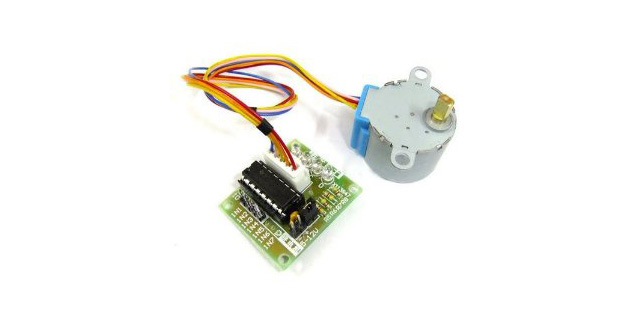
目的:通过树莓派编写一个C程序,通过其GPIO接口控制步进电机的运转速度和运转方向。
材料:正常工作并联网的树莓派、5V步进电机+ULN2003驱动板
方案:
先将5V步进电机和ULN2003驱动板连接好,可以看到驱动板上有IN1~IN4 4各输入口,这4个输入口分别对接树莓派的GPIO口。同时,需要利用树莓派的5V GPIO口为步进电机供电(5V GPIO口接驱动板正级,0V GPIO接驱动板负级)。
将树莓派上GPIO 17、18、21、22分别对应步进电机驱动板的IN1、IN2、IN3、IN4口。
接下来需要编程,将IN1~IN4口依次传入高电平(步进电机运行原理)即可驱动步进电机。
利用WiringPi(安装教程)的库来写如下代码:
touch motor.c
nano motor.c
粘贴如下代码:
/* moto.c
* A program to control a stepper motor through the GPIO on Raspberry Pi
*
* Author: Darran Zhang (http://www.codelast.com)
*/#include <wiringPi.h>#include <stdio.h>#include <unistd.h>#include <stdlib.h>#define CLOCKWISE 1#define COUNTER_CLOCKWISE 2voiddelayMS(intx);voidrotate(int* pins,intdirection);intmain(intargc,char* argv[]) {if(argc < 4) {printf("Usage example: ./motor 0 1 2 3 n");return1;}/* number of the pins which connected to the stepper motor driver board */intpinA =atoi(argv[1]);intpinB =atoi(argv[2]);intpinC =atoi(argv[3]);intpinD =atoi(argv[4]);intpins[4] = {pinA, pinB, pinC, pinD};if(-1 == wiringPiSetup()) {printf("Setup wiringPi failed!");return1;}/* set mode to output */pinMode(pinA, OUTPUT);pinMode(pinB, OUTPUT);pinMode(pinC, OUTPUT);pinMode(pinD, OUTPUT);delayMS(50);// wait for a stable statusfor(inti = 0; i < 500; i++) {rotate(pins, CLOCKWISE);}return0;}/* Suspend execution for x milliseconds intervals.* @param ms Milliseconds to sleep.*/voiddelayMS(intx) {usleep(x * 1000);}/* Rotate the motor.* @param pins A pointer which points to the pins number array.* @param direction CLOCKWISE for clockwise rotation, COUNTER_CLOCKWISE for counter clockwise rotation.*/voidrotate(int* pins,intdirection) {for(inti = 0; i < 4; i++) {if(CLOCKWISE == direction) {for(intj = 0; j < 4; j++) {if(j == i) {digitalWrite(pins[3 - j], 1);// output a high level}else{digitalWrite(pins[3 - j], 0);// output a low level}}}elseif(COUNTER_CLOCKWISE == direction) {for(intj = 0; j < 4; j++) {if(j == i) {digitalWrite(pins[j], 1);// output a high level}else{digitalWrite(pins[j], 0);// output a low level}}}delayMS(4);}}
g++ motor.c -o motor -lwiringPi //编译程序
./motor 0 1 2 3 //运行程序,向程序传入4个参数分别代表要控制的树莓派的GPIO口编号(由于使用的时WiringPi库)。调整传入参数的顺序,可以控制步进电机的转向。这时步进电机应该已经开始低转速运转,说明驱动成功。以上代码中,如果要改变步进电机的转速,我们只需要把改变rotate()函数中每次delay的时间即可。如果我们把delay的时间逐渐由大变小,步进电机就会呈加速状态。让步进电机周期性加速的完整代码如下:
/* motor_speed_up.c* A program to control a stepper motor(speed up) through the GPIO on Raspberry Pi.** Author: Darran Zhang (http://www.codelast.com)*/#include <wiringPi.h>#include <stdio.h>#include <unistd.h>#include <stdlib.h>#define CLOCKWISE 1#define COUNTER_CLOCKWISE 2voiddelayMS(intx);voidrotate(int* pins,intdirection,intdelay);voidstop(int* pins);intmain(intargc,char* argv[]) {if(argc < 4) {printf("Usage example: ./motor 0 1 2 3 n");return1;}/* number of the pins which connected to the stepper motor driver board */intpinA =atoi(argv[1]);intpinB =atoi(argv[2]);intpinC =atoi(argv[3]);intpinD =atoi(argv[4]);intpins[4] = {pinA, pinB, pinC, pinD};if(-1 == wiringPiSetup()) {printf("Setup wiringPi failed!");return1;}/* set mode to output */pinMode(pinA, OUTPUT);pinMode(pinB, OUTPUT);pinMode(pinC, OUTPUT);pinMode(pinD, OUTPUT);delayMS(50);// wait for a stable statusintdelay = 25;while(true) {for(inti = 0; i < 10; i++) {rotate(pins, CLOCKWISE, delay);}delay--;if(delay < 4) {delay = 25;stop(pins);delayMS(500);}}return0;}/* Suspend execution for x milliseconds intervals.* @param ms Milliseconds to sleep.*/voiddelayMS(intx) {usleep(x * 1000);}/* Rotate the motor.* @param pins A pointer which points to the pins number array.* @param direction CLOCKWISE for clockwise rotation, COUNTER_CLOCKWISE for counter clockwise rotation.* @param delay The time intervals(in ms) to delay, and if the value is smaller, the motor rotates faster.*/voidrotate(int* pins,intdirection,intdelay) {for(inti = 0; i < 4; i++) {if(CLOCKWISE == direction) {for(intj = 0; j < 4; j++) {if(j == i) {digitalWrite(pins[3 - j], 1);// output a high level}else{digitalWrite(pins[3 - j], 0);// output a low level}}}elseif(COUNTER_CLOCKWISE == direction) {for(intj = 0; j < 4; j++) {if(j == i) {digitalWrite(pins[j], 1);// output a high level}else{digitalWrite(pins[j], 0);// output a low level}}}delayMS(delay);}}/* Stop the motor.* @param pins A pointer which points to the pins number array.*/voidstop(int* pins) {for(inti = 0; i < 4; i++) {digitalWrite(pins[i], 0);// output a low level}}
修改完程序再试试看?
参考文章:http://www.codelast.com/?p=5232









